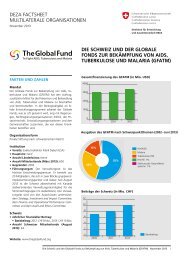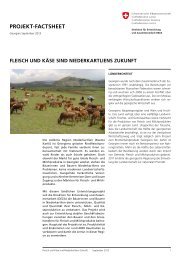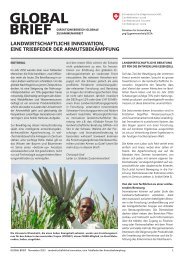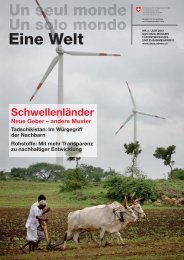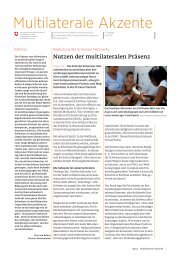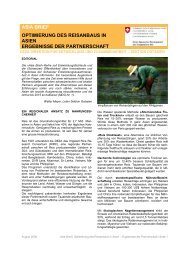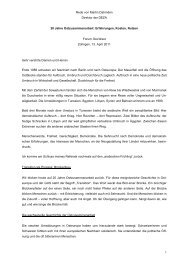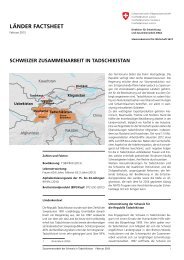12 Jahre Ostzusammenarbeit - Evaluation 2003/4 - Band 2 - DEZA
12 Jahre Ostzusammenarbeit - Evaluation 2003/4 - Band 2 - DEZA
12 Jahre Ostzusammenarbeit - Evaluation 2003/4 - Band 2 - DEZA
Erfolgreiche ePaper selbst erstellen
Machen Sie aus Ihren PDF Publikationen ein blätterbares Flipbook mit unserer einzigartigen Google optimierten e-Paper Software.
institutional aspects and management; over the years, however, the approach of the financial<br />
assistance was considerably more integrated. The efforts of seco to better balance the instruments<br />
are reflected in a slow change towards the other instruments. However, private<br />
sector promotion, as well as trade and environment-friendly technology promotion could have<br />
played a more substantial role in seco’s programme from the start. Hence, an increasing<br />
proportion of seco’s projects are parallel financing and co-financing with Bretton Woods Institutions<br />
and EBRD. On the one hand they allowed for a better embedding of Swiss efforts,<br />
however, particularly concerning co-financing, several weaknesses were identified, such as:<br />
little visibility of Swiss support, high dependency on the “big” partner, and small learning effect<br />
for seco.<br />
The cooperation of seco and SDC has generally been appraised by counterparts as flexible,<br />
needs-oriented and non-bureaucratic.<br />
Given the large “unfinished agenda” in many countries in transition, and bearing in mind the<br />
good results and experience acquired from the cooperation of seco and SDC with the East, a<br />
continuation of the Swiss cooperation is strongly recommended. Any possible Swiss contribution<br />
to the cohesion fund of the European Union, or the financing of projects through other<br />
channels in favour of immediate EU candidate countries, should not be made at the expense<br />
of the cooperation programmes of seco and SDC.<br />
Lessons learnt<br />
The scope and time requirements needed to cope with the challenges of the transition process<br />
were initially underestimated by the donor community as well as by the recipient countries.<br />
The often unpredictable dynamics and changing national priorities required a permanent<br />
adjustment of policies and instruments. SDC and seco were able to apply the various<br />
instruments in a flexible manner. The overall success of the Swiss programme was mainly<br />
due to: a) a blending of Swiss know-how and investments with local needs and capacities, b)<br />
a continuous improvement of the professional quality of cooperation and a valorisation of<br />
learning processes, c) an improved collaboration between SDC and seco with increasing experience<br />
by taking advantage of the different strengths of the various cooperation instruments,<br />
and d) the establishment of joint cooperation offices with country programmes in <strong>12</strong><br />
countries. These joint efforts allowed the further delegation of implementation to local partners<br />
(governmental as well as civil and private sector), to improve monitoring and controlling,<br />
and to strengthen the policy dialogue. Flexibility in designing the approaches, selecting the<br />
instruments and in administration are particularly appreciated by the local partners.





